There’s no shortage of Internet advice on how to tell if a diamond is real, yet much of this information is wrong, and some methods can even damage your gem. Read on to learn about the best way to tell if your diamond is real.
Let’s start with the spoiler, because if you read no further, know this: the most reliable way to authenticate your diamond is to consult a trained gemologist or send it to an independent gemological laboratory for analysis.
A lab, like GIA, will have the expertise and technology to distinguish between natural diamonds, diamond simulants (or imitations), and synthetic diamonds and to detect diamond treatments.
If your diamond already has a GIA diamond report, like a GIA Diamond Grading Report or GIA Diamond Dossier®, you know you have a real diamond. The reports not only identify the diamond, they also provide an unbiased assessment of your diamond’s quality according to the 4Cs: color, clarity, cut and carat weight. The reports also disclose any treatments the diamond may have undergone to improve its color appearance or clarity.
You can even verify your report by visiting GIA Report Check, GIA’s online database, and entering your diamond’s report number to see the grading details of your diamond.
How to Get a GIA Diamond Grading Report?
If you don’t have a GIA report and would like to get one, you can ask your local fine jeweler to send your stone to GIA for you. Your jeweler will be familiar with any shipping and insurance requirements, and will be able to explain the contents of your GIA report once it’s returned to you. Find a jeweler near you.
Do-it-Yourself Diamond Tests – Myth & Fact
If you’ve read this far, you’re probably still wondering if there is an “easy” way to determine whether your local estate find will put the kids through college. Here are some tests we’ve found online – and reasons why you should avoid them!

Natural diamond and various diamond simulants. Top row (left to right): Natural diamond, synthetic rutile, gadolinium gallium garnet (GGG), and synthetic spinel. Bottom row (left to right) strontium titanate, synthetic corundum, yttrium aluminum garnet (YAG), and colorless zircon. Photo: Robert Weldon/GIA.
Myth: Use a jeweler’s loupe to examine a stone. A real diamond will have inclusions. A “fake” diamond will be perfect.
Fact: Most consumers have difficulty using a loupe and spotting inclusions: unless you have some experience looking at diamonds, the reflections and facet junctions can make it difficult to see small inclusions. Also, some diamonds are flawless and you will see no inclusions!
While it’s true that most diamonds, as products of nature, will have inclusions, it is a myth that diamond imitations, whether they are natural or synthetic, will not have inclusions. Inclusions are the result of a gem’s crystal growth process. In fact, inclusions help gemologists identify natural and synthetic gems. Also, glass imitations can have gas bubbles, which could look like natural inclusions to an untrained eye.
Natural gems that might look like diamonds to the average consumer include: colorless sapphire, colorless topaz, and colorless zircon.
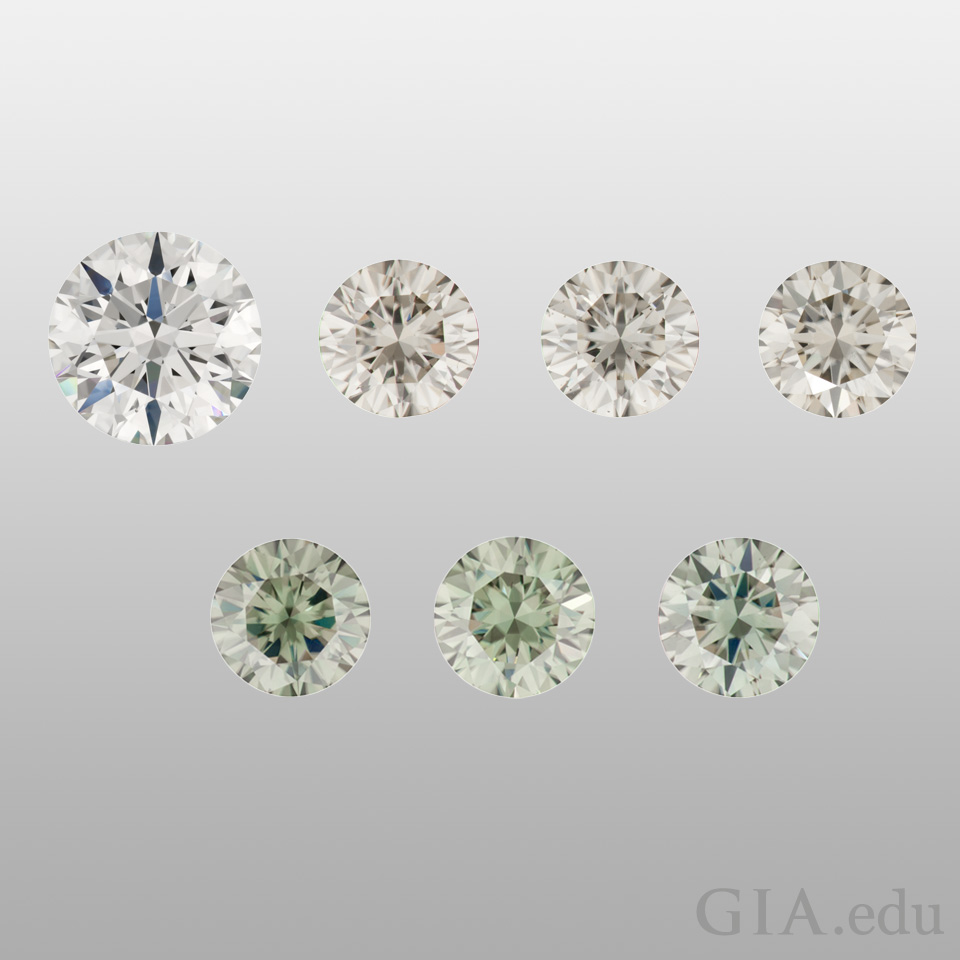
A natural diamond (upper left) with six smaller laboratory grown moissanite in the near colorless to greenish range. Photo: Robert Weldon/GIA
Many natural gems have a synthetic (i.e., lab-grown) counterpart. The man-made material will have essentially the same chemical composition, crystal structure and optical and physical properties as the natural gem gemstone.
Some of these man-made gems are used to imitate diamond: synthetic rutile, colorless synthetic spinel, and colorless synthetic sapphire. There are also man-made diamond imitations that do not have natural gem counterparts. These are solely the product of man’s ingenuity in the laboratory, like YAG (yttrium aluminum garnet), GGG (gadolinium gallium garnet), CZ (synthetic cubic zirconia), and synthetic moissanite.
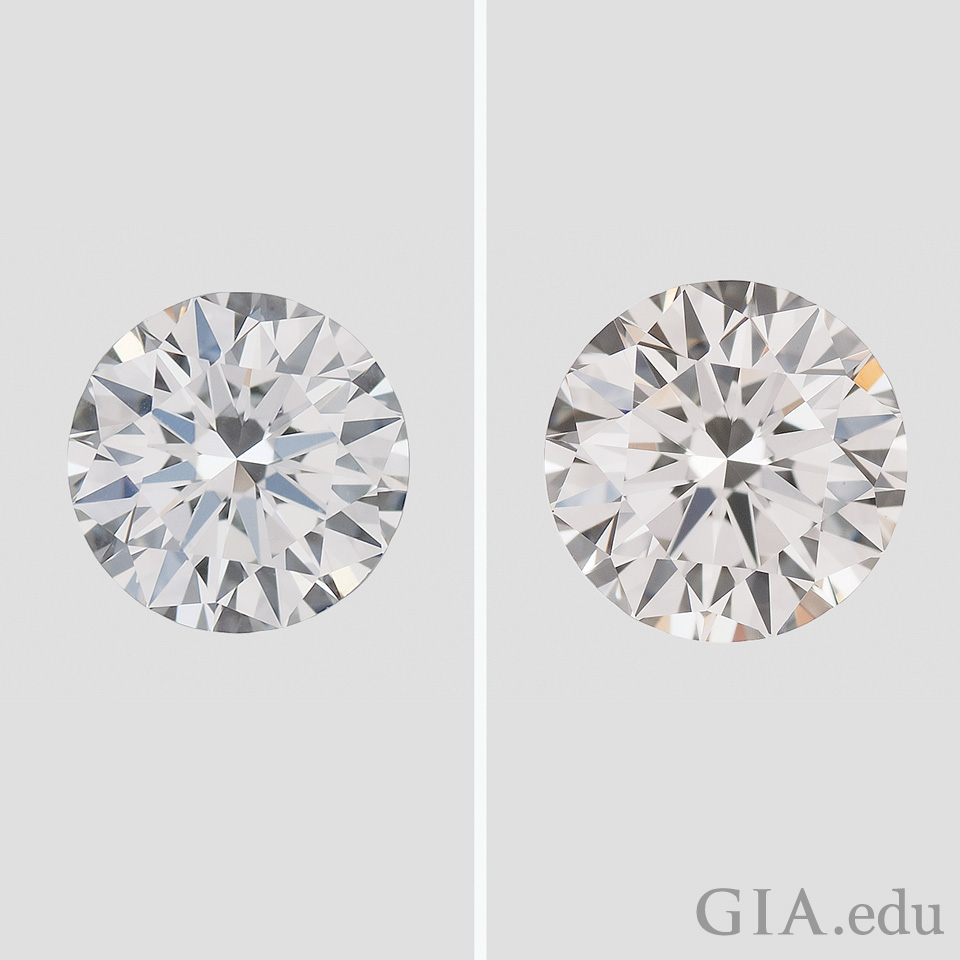
Two synthetic diamonds graded by GIA. The 0.39 carat (ct) on the left was graded F color and VVS2 clarity. The 0.83 ct diamond on the right was graded J color and VVS2 clarity. Photo: Jian Xin (Jae) Liao/GIA
Synthetic diamonds are not imitations. They are real diamonds.
Synthetic diamonds are also man-made and have the same properties as natural diamonds. Synthetic diamonds are real diamonds. But the price difference between lab-grown and natural diamonds can be considerable. You cannot spot a synthetic diamond by looking at it through a loupe. The only way to tell is by laboratory testing.
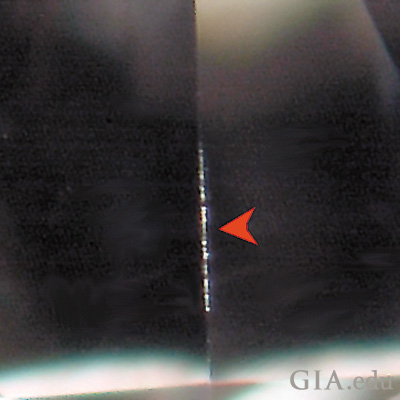
Contrary to popular myth, real diamonds don’t always have sharp edges. Diamonds can have abrasions: a series of minute nicks along the facet junctions that give the diamond’s edges a white or fuzzy appearance. This clarity characteristic will be noted on GIA diamond grading reports. Photo: Mitchell Moore/GIA
Myth: A real diamond will have sharp edges, a “fake” diamond will not.
Fact: This is only true for imitations that are made in a mold, like plastic (and some glass). A natural diamond will have sharp edges, but so will synthetic diamonds and any gem material used to imitate diamond. In addition, any gem, natural or synthetic, can have abraded facet junctions (the line where two facets meet) caused by damage or wear and tear.
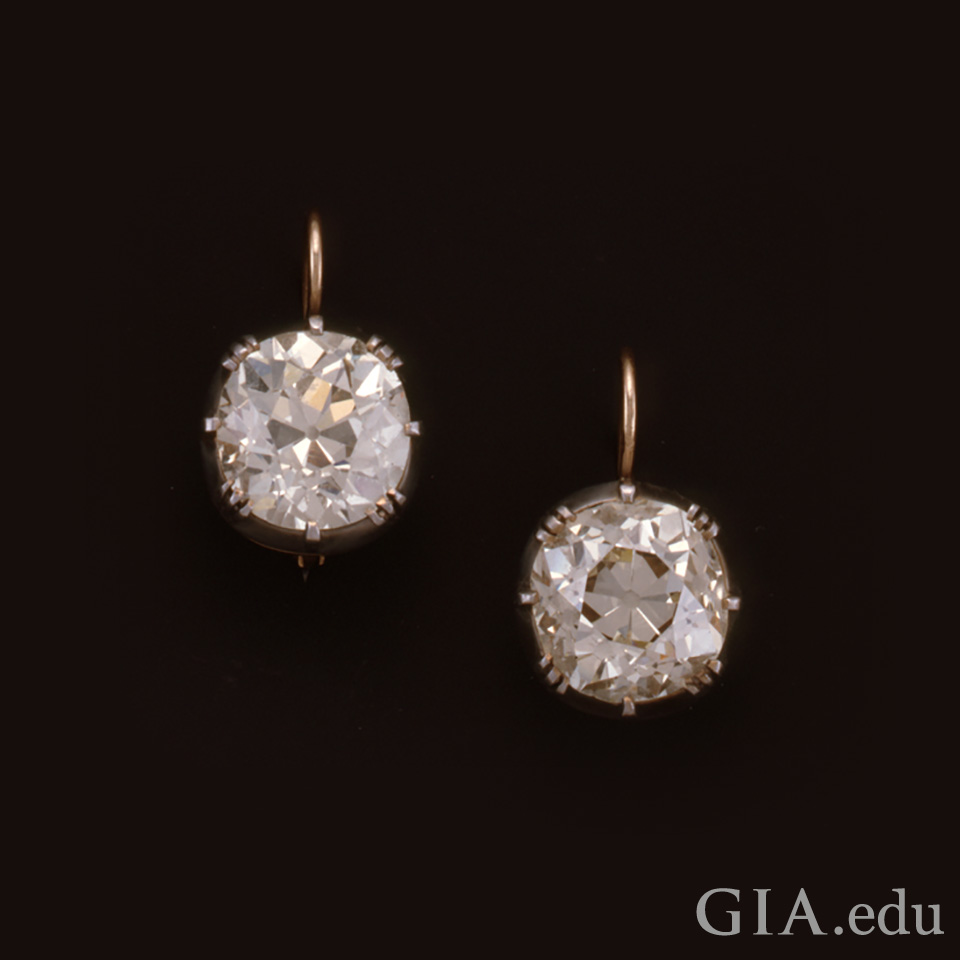
If you’re unfamiliar with antique jewelry, the settings of these circa 1860 Victorian gold and silver earrings may not seem like the highest quality. But don’t be too quick to write off the gemstones based on setting alone. The earrings feature a pair of old mine-cut diamonds with a total weight of 11.94 carats. Photo: David Behl. Copyright: Janet Mavec & GIA
Myth: You can spot a real diamond by the quality and metal of its setting.
Fact: While natural diamonds are often set in gold or platinum, the metal alone is not a definitive clue. Because of the high cost of gold and platinum, diamonds today are sometimes set in silver metal, too. Antique jewelry can contain diamonds set in a mix of gold and silver.
The style of the setting is also not a good clue. Diamonds are set in a variety of mountings. And a poor quality setting does not necessarily mean the diamonds aren’t real. The quality could just be a sign of general wear and tear or work done by an inexperienced jeweler.
Myth: Rub the gem with sandpaper. A diamond won’t be scratched.
Fact: This is a destructive test and should never be used! The grit on sandpaper usually has a hardness between 7 and 9 on the Mohs scale, so using sandpaper on material softer than the grit will damage it. You risk not only scratching the metal if the stone is set, but also abrading the surface of the gem and diminishing its value.
Myth: The fog test: Breathe on the gem. A real diamond will not fog.
Fact: This test cannot be replicated with consistent results. Internet advice doesn’t tell us how long one must breathe on the gem to see results. Nor does it tell us how large the surface area of the gem needs to be so that you can actually see the fogging. Synthetic diamonds and natural diamonds will react in exactly the same way. Ambient humidity might also affect your results.

Cutting style can have an effect on a diamond’s visual appearance. The round brilliant cut natural diamond (top) appears brighter than the emerald cut natural diamond (bottom). Both diamonds are set in platinum. Courtesy: JK & Co. Jewelers
Myth: If it sparkles, it must be a real diamond.
Fact: Many consumers use the word “sparkle” in a very generic way to describe the overall visual effect of a faceted gemstone’s interaction with light. To an untrained eye, almost any faceted gem like synthetic moissanite, synthetic cubic zirconia (CZ), or a colorless natural zircon will sparkle.
On the other hand, an emerald cut diamond does not sparkle like some of these round brilliant diamond simulants.
When gemologists refer to a diamond’s sparkle, it means something very specific: scintillation. In addition to sparkle, scintillation also refers to the pattern of light and dark areas caused by reflections within the diamond. Scintillation is only one aspect of a diamond’s appearance; other factors are brightness (the internal and external white light reflected from a diamond when it is viewed face-up) and fire (the scattering of white light into all the colors of the rainbow). It’s the combination of these factors that give diamonds their unique visual appearance.
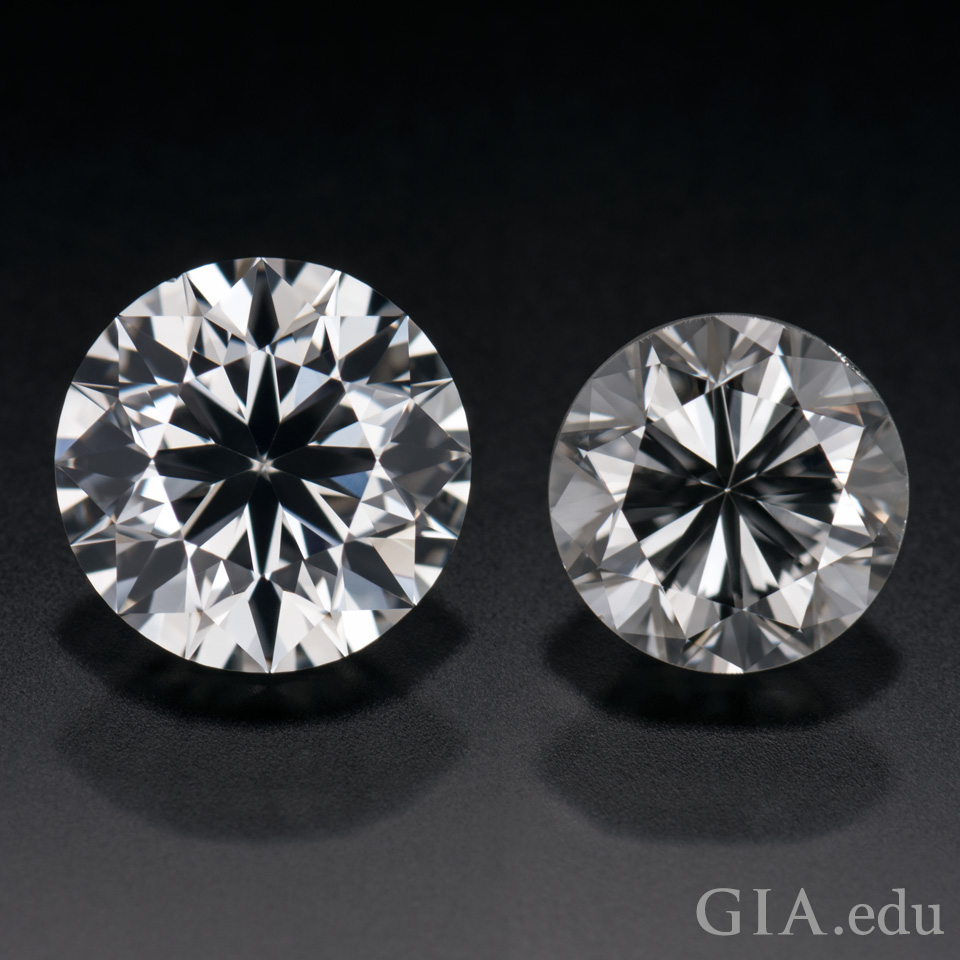
Two round brilliant cut diamonds selected to show how the quality of the cut affects visual characteristics. The Excellent cut (left) is much brighter than the Poor cut (right). Photo: Kevin Schumacher/GIA
Sparkle, or more accurately scintillation, depends on many variables:
- Cutting style: A brilliant cut diamond will usually appear brighter than a step cut diamond, even when they have the same number of facets and the same shape. This difference in appearance is due to the arrangement of the facets.
- Number of facets: The more facets a diamond has, the more reflective surfaces to bounce and scatter light. A round brilliant cut diamond with its 57 or 58 facets will appear to have more sparkle than a single cut diamond with only 17 or 18 facets.
- Cut quality: A poorly cut diamond is still a diamond, but it may not deliver the visual effect you would expect. Do not assume that a diamond that does not sparkle is not a diamond.
- Lighting: A diamond will appear differently under diffused lighting versus spot lighting. Find out how light affects the appearance of a diamond.
- Cleanliness: A diamond that’s dirty will not sparkle. Diamonds have an affinity for grease, so it’s important to clean them regularly. Find out how to keep your diamond clean.
Myth: The newspaper test: You can’t see the type through a real diamond.
Fact: This is another problematic test. The logic behind it is that a well-cut modern round brilliant diamond is highly refractive, meaning that as light passes through it, the light slows down and bends. As you look through the diamond to the newspaper, the refraction causes a visual distortion, making the newsprint unreadable.
While this test can give a quick indication if you’re a trained and experienced gemologist, it can be very confusing and misleading for the inexperienced. It should never be used as a definitive test. Many variables can affect the results, for instance lighting conditions and surroundings, whether the stone is clean or dirty, the placement of the stone on the newspaper, the tester’s eyesight, the shape and proportions of the gemstone being tested, and/or whether it is mounted.

A round brilliant cut natural diamond complemented by 14 round brilliant diamonds in 18K rose gold. Courtesy: JK & Co. Jewelers
Unfortunately, there are no easy and reliable at-home tests that will conclusively tell you if your gemstone is a natural diamond or some other material. Your best recourse is to take your jewelry to a trained jeweler for examination and, if necessary, request to have the gemstone tested by an independent gemological laboratory.
Ready to dig deeper into diamonds? Read on to learn all about where diamonds come from.

